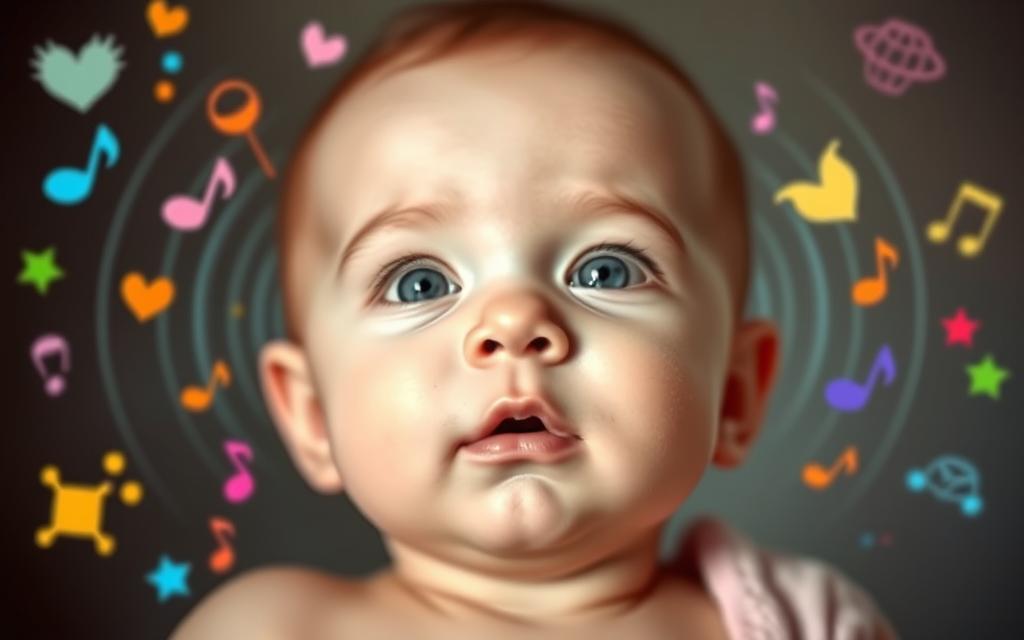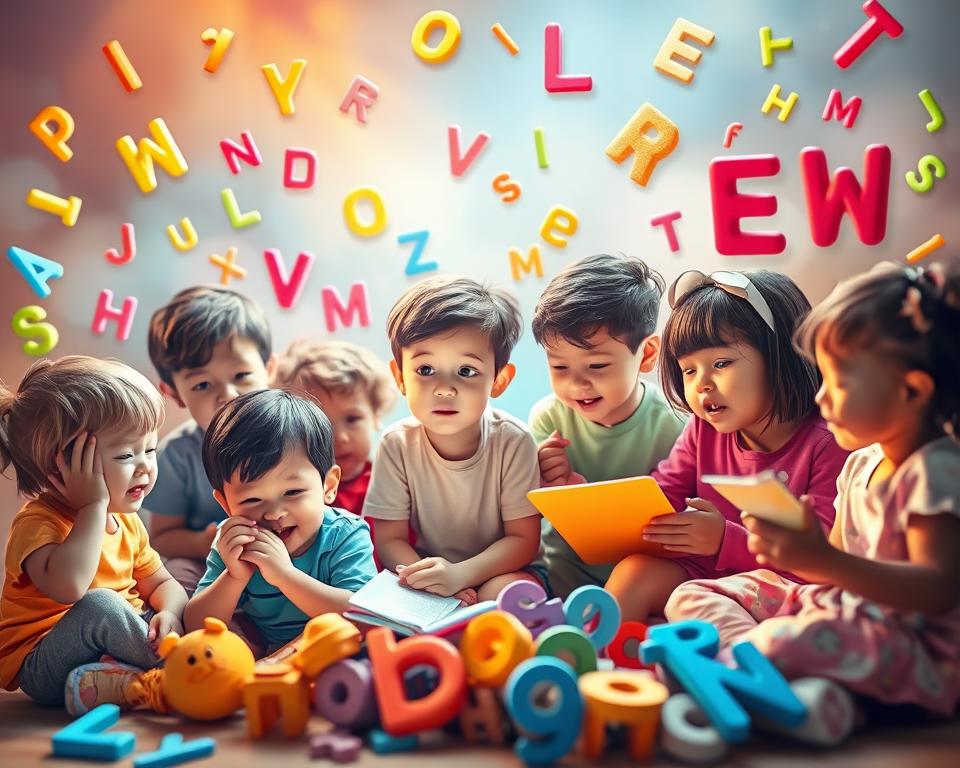By 3 months, 85% of babies startle when they hear their name or familiar voices. This shows how fast language skills grow in young children. Knowing about these stages is key for parents, teachers, and doctors to spot and help with language problems early on. This can make a big difference, improving language skills by up to 50%.
Learning to speak, listen, read, and write is a big part of growing up. By age 2, kids hit important speech milestones. These skills are vital for their brain and social development.
It’s very important to understand and support these language milestones. The National Institute on Deafness and Other Communication Disorders says they are crucial for a child’s growth.
Understanding Language Development Milestones
Language development is a complex process. It involves reaching various linguistic milestones. These milestones are key for a child’s growth in cognition, social skills, and emotions. The first three years are especially important for learning speech and language skills.
Brain development is closely tied to cognitive language skills. Knowing this helps spot language disorders early. It also helps in providing the right support. Recognizing the importance of these milestones helps parents and caregivers support children’s language skills.
Important milestones include babbling, gesturing, and speaking. These are achieved through a mix of innate abilities and environmental factors. Monitoring a child’s progress and offering support helps them overcome challenges. This way, they can reach their full potential in language skills.
The Foundation of Early Communication
Early language milestones are key in childhood language development. They set the stage for future communication skills. The American Speech-Language-Hearing Association says babies as young as six months start to recognize sounds of their native language. By 12 months, they begin to babble and make cooing sounds, which are important early steps.
Research shows that good communication starts in the first year of life. Activities with parents and caregivers help a lot with language learning and future school success. Infants start to communicate through sounds, gestures, and facial expressions as early as 2 months. By 4 months, they make cooing sounds and respond to being spoken to, showing they are getting better at language.
Some key early language milestones include:
- By 3 months: hearing and understanding sounds, making cooing sounds, and responding with smiles to familiar voices
- By 6 months: recognizing basic sounds of native language
- By 12 months: babbling and making cooing sounds, saying first words
Monitoring a child’s development can aid in identifying any potential problems at an early stage. The CDC’s milestone checklists help parents track their child’s progress, including communication skills. Talking with a doctor about these milestones can help catch problems early and get the right help fast.
Early intervention programs are often free or low-cost in the United States. Studies show that early treatment works best for communication problems. By supporting early language milestones, parents and caregivers are crucial in helping children develop healthy language skills and succeed in school.
Birth to Six Months: Pre-linguistic Development
From birth to six months, babies start learning language skills. This early stage is key for future language growth. At first, they mainly use crying and cooing to communicate. These sounds help them build the muscles needed for speech.
During the first six months of a baby’s life, they undergo a significant amount of development in terms of communication and language. Before they are able to speak their first words, babies go through a pre-linguistic stage where they communicate through sounds, gestures, and facial expressions.
One of the first ways that babies communicate in the pre-linguistic stage is through crying. Crying is a baby’s way of letting their caregivers know that they are in need of something, whether it be food, comfort, or a diaper change. As caregivers respond to a baby’s cries, they begin to learn that their cries elicit a response, laying the foundation for future communication.
Newborns begin their language journey early, able to distinguish different sounds. By two to four months, they start to notice the tone of voices. This shows they’re beginning to understand speech patterns.
As they grow, crying becomes less common, and cooing sounds start. This is the start of playing with sounds and learning to speak.

Around two months of age, babies start to coo and make vowel sounds such as “ooh” and “aah.” These early vocalizations are a way for babies to experiment with their vocal cords and begin to develop the muscles needed for speech. Caregivers often respond to these coos and vocalizations with smiles and encouragement, reinforcing the baby’s attempts at communication.
By three to four months of age, babies start to babble, repeating strings of consonant-vowel sounds like “bababa” or “dadada.” This babbling is an important milestone in pre-linguistic development, as babies begin to experiment with different sounds and syllables. Caregivers can encourage this babbling by responding with repetition, imitation, and talking to the baby in a sing-song voice.
Around five to six months of age, babies begin to engage in reciprocal communication, taking turns in a “conversation” with their caregivers. Babies may start to imitate facial expressions, gestures, and sounds that they see and hear, showing an increased awareness of social cues and interactions.
Early social interactions are also important for language learning. Babies start to know and talk back to their caregivers. By six months, they’re ready to learn the sounds of vowels and consonants. This is crucial for speaking like a native.
Overall, the first six months of a baby’s life are a critical period for pre-linguistic development. Caregivers can support this development by responding to a baby’s vocalizations, engaging in back-and-forth interactions, and providing a nurturing and stimulating environment for communication to thrive. By understanding and encouraging a baby’s pre-linguistic development, caregivers can lay a strong foundation for future language acquisition and communication skills.
Knowing about these early steps in language learning helps parents and caregivers. It lets them support their child’s language growth right from the start.
Six to Twelve Months: First Words and Gestures
Babies start to hit big speech development milestones around this time. They say their first words and use gestures to talk. The National Institute on Deafness and Other Communication Disorders says babies usually say their first word by 12 months. By 12 months, they might say “dada,” “mama,” and “uh-oh.”
Some important linguistic milestones include:
- Understanding simple commands, showing they get common phrases
- Saying a few words, like “dada” or “mama”
- Using gestures to talk, like waving or pointing
Around six months old, your baby may start babbling in a more intentional way, using different sounds and tones to communicate. They may begin to imitate simple sounds or words that they hear frequently, such as “mama” or “dada.” While these early words may not always be clear or consistent, they are an important step in your baby’s language development.
By around twelve months old, many babies start to say their first real words with more clarity. These may include common words like “hi,” “bye-bye,” “dog,” or “ball.” Your baby may also start to understand and respond to simple commands or questions, such as “wave bye-bye” or “where’s the ball?”
In addition to developing spoken language, babies at this age also begin to use gestures to communicate. They may point to objects that interest them, raise their arms to be picked up, or shake their head to indicate “no.” These early gestures are a crucial part of your baby’s communication toolbox and can help bridge the gap between what they want to say and what they are able to express verbally.
Encouraging your baby’s communication development during this stage is crucial. Responding to their babbling, repeating words, and using gestures yourself can all help reinforce their budding language skills. Reading to your baby, talking to them frequently, and singing songs together can also help stimulate their language development.
Keep in mind, each child develops at a unique pace. Some might hit these speech development milestones sooner or later. But by 12 months, most babies should follow simple instructions. By 18 months, they should say about 10 words.

Remember that every baby develops at their own pace, so don’t panic if your baby’s first words or gestures don’t come right on schedule. However, if you have concerns about your baby’s language development, don’t hesitate to talk to your pediatrician. With the right support and encouragement, your baby will continue to grow and thrive in their communication skills in the months to come.
Parents can help their child’s language skills by talking, reading, and doing activities that boost linguistic milestones. This support helps them reach these key milestones and prepares them for more in language development.
Toddler Language Development: One to Two Years
Toddlers go through big changes in language during this time. They learn new words fast, especially between 12 and 18 months. Studies show they can understand many more words than they can say.
Language development is a crucial milestone for toddlers as they transition from baby babble to forming words and sentences. Between the ages of one to two years old, toddlers go through rapid changes in their ability to communicate and understand language. It is during this time that parents may start to notice their child’s first words and their growing ability to communicate their needs and wants.
One of the major language milestones that toddlers reach around this age is the development of their vocabulary. By the age of one, most toddlers can say a few simple words such as “mama” and “dada”. As they approach their second birthday, toddlers start to add more words to their vocabulary and may start to form simple sentences. It is important for parents to engage with their child by talking to them and reading to them regularly to help support their language development.
Another important aspect of language development during this stage is the understanding of language. Toddlers around the age of one start to understand simple commands and directions, such as “give me the ball” or “come here”. As they approach their second birthday, toddlers start to understand more complex language and may even be able to follow a sequence of two or three commands.
Toddlers also start to show their social communication skills during this stage of language development. They may start to point to objects to show interest or to request something. They may also start to imitate gestures and actions, as well as start to engage in simple back-and-forth conversations with their caregivers.
It is important for parents to be patient and supportive during this stage of language development. Every child develops at their own pace, so it is important not to compare your child’s progress to others. Encouraging your child to communicate through gestures, words, and sounds will help to support their language development and set them up for success as they continue to grow and learn.
As they grow, toddlers start making simple sentences. By two years old, they know about 100 to 200 words. They might say things like ‘all gone’ or ‘daddy bye-bye’ and follow two-word instructions.
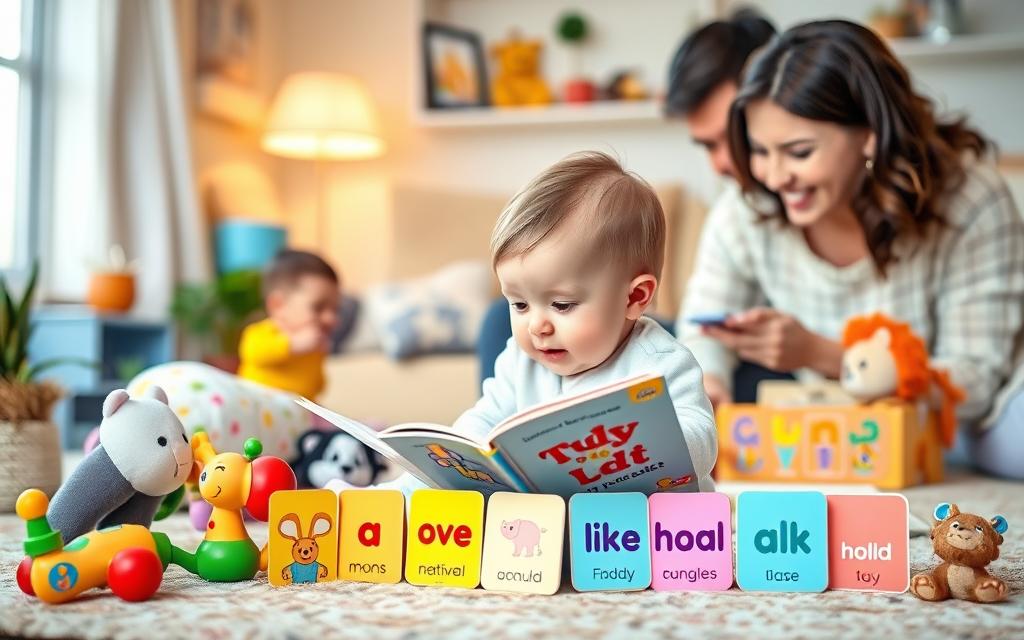
- Pointing to body parts when named
- Sustaining interest in a book or pictures for two or more minutes
- Understanding complex sentences and recognizing names of common objects and pictures
Keep in mind, each child progresses at their own pace. Some might need extra help. If you’re worried about your child’s language acquisition stages, talk to a speech and language therapist.
Preschool Communication Skills: Three to Four Years
At three to four years old, kids make big strides in cognitive language development. They build on early language milestones from before. The American Speech-Language-Hearing Association says kids use about 1,000 words by this age.
This is a key time for learning to talk and social skills. Kids start to get better at talking to others and understanding feelings.
When it comes to preschool-age children, communication skills are crucial not only for social interactions but also for academic readiness. At three to four years old, children are at a developmental stage where they are rapidly expanding their vocabulary and refining their ability to communicate effectively.
During this stage, children are able to use more complex sentences and have a basic understanding of grammar rules. They can also carry on a conversation with others, ask questions, and express their thoughts and feelings more clearly. Additionally, children are beginning to develop their listening skills, which is essential for cognitive development and learning.
One important aspect of communication at this age is the ability to tell stories and describe events in a logical sequence. This skill is important for developing narrative skills, which are a precursor to reading comprehension and writing abilities. By encouraging children to tell stories and talk about events in their lives, parents and teachers can help them develop strong communication skills.
Another important aspect of communication for three- to four-year-olds is the ability to understand and follow directions. Children at this age should be able to listen to verbal directions and carry out simple tasks. This skill is important for classroom readiness and for developing independence and problem-solving abilities.
It is also important for children at this age to develop their social communication skills. This includes learning how to take turns in conversations, how to express empathy and understanding towards others, and how to resolve conflicts peacefully. By providing opportunities for children to interact with their peers and practice these skills, parents and teachers can help them develop strong social communication skills.
Some important language skills at this age include:
- Using 3-word sentences, progressing to 4-word sentences by age 4
- Understanding and following instructions with more than 2 steps
- Expressing basic emotions like ‘happy’, ‘sad’, ‘angry’, or ‘surprised’
- Asking a lot of ‘what’, ‘why’, ‘where’, ‘who’, and ‘how’ questions

Children at this age understand words for actions, sizes, and places. They can talk about how people use things and answer simple questions.
It’s important to watch how a child talks and seek help if they seem slow. Early help can make a big difference. It helps kids reach their full potential in cognitive language development and early language milestones.
Advanced Language Skills: Four to Five Years
At four to five years old, kids make big strides in their language skills. They start to form complex sentences. This helps them share their thoughts and ideas better.
By the time a child reaches the age of four to five years old, their language skills have significantly developed, and they are able to communicate more effectively. At this stage, children have a strong grasp of grammar rules, vocabulary, and syntax, allowing them to form more complex sentences and have more in-depth conversations.
One of the key milestones in language development at this age is the ability to tell stories and narratives. Children are able to engage in imaginative play and create elaborate tales, showing a deep understanding of sequencing and structure. They may also be able to retell stories they have heard or read, demonstrating their comprehension skills.
Additionally, four- to five-year-olds have a larger vocabulary and are able to use a wider range of words to express themselves. They are able to ask more complex questions and engage in more detailed conversations with others. Their ability to use descriptive language also improves, allowing them to paint vivid pictures with their words.
Furthermore, children at this age begin to understand more abstract concepts and can engage in more sophisticated discussions. They are able to express their thoughts and feelings more clearly and are better able to understand the perspectives of others. This increased level of empathy and understanding makes communication more fulfilling and effective.
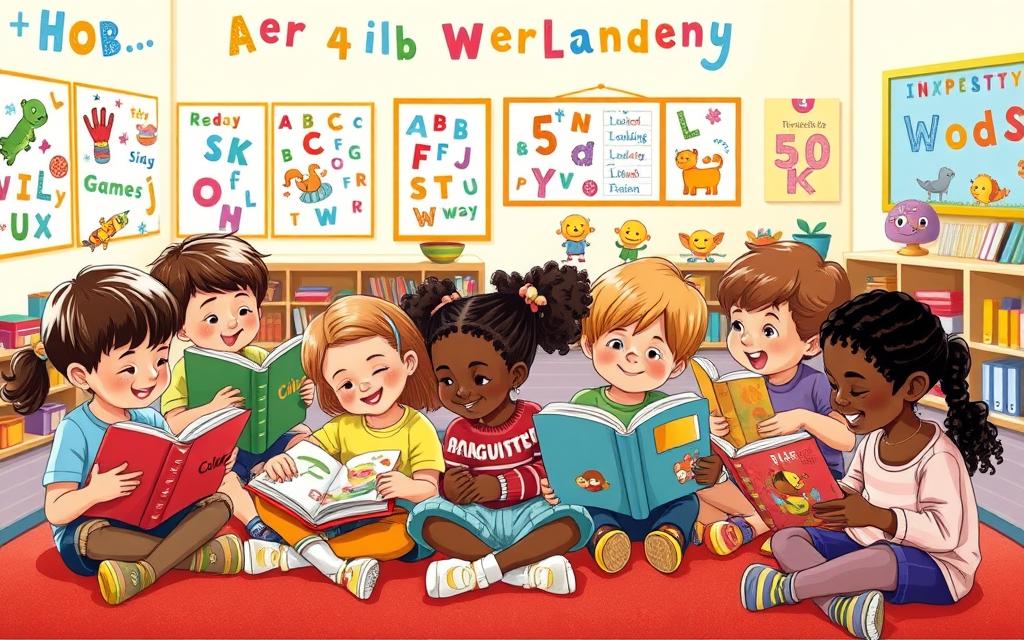
Studies show that by 4.5 years, almost all kids can be understood by strangers. This shows a big leap in their communication skills. By age 5, they can use sentences with up to 9 words, showing their growing language skills.
- Using sentences of up to 9 words in length
- Understanding words like ‘before’, ‘after’, and ‘next week’
- Getting the difference between passive and active voice
- Asking lots of questions, especially by age 5
Learning language is a step-by-step process. By age 5, kids usually know 1,000 to 2,000 words. They can make sentences with six to eight words. They also learn the alphabet by this age, showing how fast they learn.
Supporting Your Child’s Language Growth
Parents are key in helping their child grow their language skills. By reading together every day and making their home a place where language thrives, parents can help a lot. This support is especially important during the early stages of learning a language.
Some ways to help include daily reading activities like reading books together. Also, using conversation strategies like asking open-ended questions can spark interesting talks. Making your home a language-rich environment can be done by labeling things and responding to your child’s attempts to talk.
Language skills are essential for communication, building relationships, and academic success. Here are some tips on how you can support your child’s language development:
1. Read to your child regularly: Reading to your child from a young age has countless benefits, including expanding their vocabulary, improving their language comprehension, and fostering a love for reading. Choose age-appropriate books that are engaging and interesting for your child.
2. Talk to your child: Engage your child in conversations throughout the day. Ask them about their day, encourage them to share their thoughts and feelings, and listen actively to what they have to say. This helps build their communication skills and confidence in expressing themselves.
3. Expand their vocabulary: Introduce new words to your child on a regular basis. You can do this through reading, everyday conversations, or playing word games. Encourage your child to use these new words in their own speech to reinforce their learning.
4. Encourage storytelling: Storytelling is a great way to boost your child’s imagination and language skills. Encourage them to create their own stories or retell their favorite stories. This helps with narrative skills, vocabulary expansion, and creativity.
5. Play language-based games: There are plenty of fun games and activities that can help your child improve their language skills. This can include word puzzles, charades, or even storytelling games. These activities make learning language more enjoyable for your child.
6. Provide a language-rich environment: Surround your child with opportunities to engage with language. This can include labeling objects around the house, listening to music or audiobooks, or watching educational television programs.
By actively supporting your child’s language growth, you are helping set them up for success in their academic and personal lives. Remember, every child develops at their own pace, so be patient and encouraging as they learn and grow. Your support and involvement make a significant impact on your child’s language development.
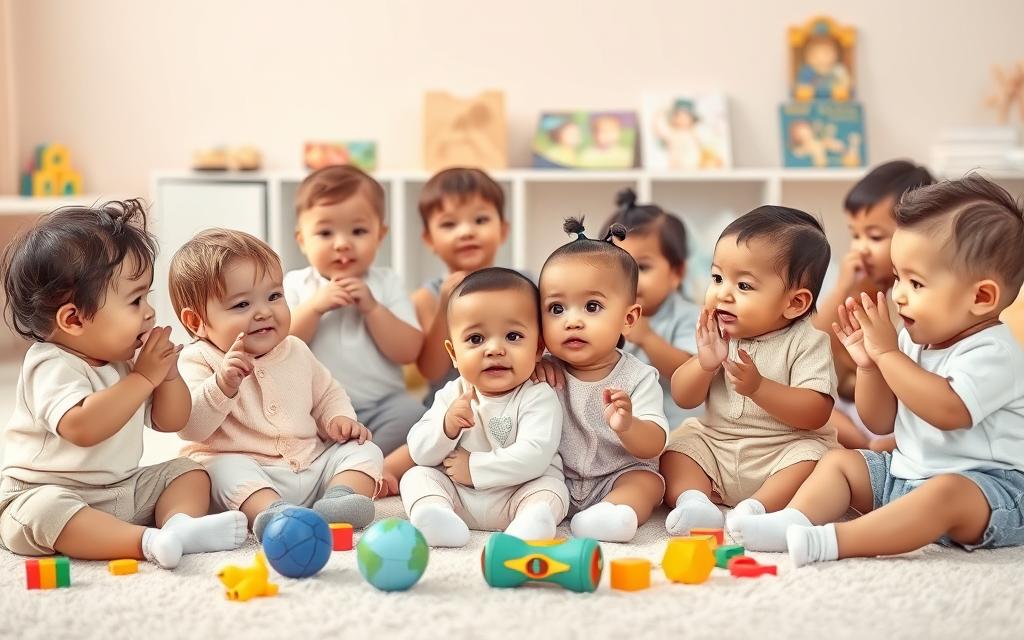
By using these strategies, parents can help their child develop strong language skills. Remember, every child learns at their own pace. So, be patient and adjust your approach as needed.
Red Flags in Language Development
It’s crucial for parents and caregivers to recognize potential delays or issues in a child’s language development. Early identification and intervention can make a big difference in a child’s language skills and overall development.
A notable concern is the absence of babbling or cooing during infancy. Typically, babies start making vowel sounds like “ahh” and “eee” around 2 months old, followed by consonant-vowel combinations like “ba” or “ma” around 4-6 months old. If a baby is not making any vocalizations by 6 months, it could be a cause for concern.
Another concern is the absence of gesturing or pointing by the age of 12 months. Pointing is an important pre-verbal communication skill that typically develops around 9-12 months old. Children who do not engage in pointing or other gesture communication may have difficulties with language development.
Another warning sign to be aware of is a delayed or limited vocabulary. By 18 months old, most children should have a vocabulary of at least 20 words, and by 2 years old, they should be combining words into simple phrases. If a child is not meeting these milestones, it could be a sign of a language delay.
Difficulty following directions or understanding simple questions can also be a red flag for language development issues. By 2 years old, children should be able to follow simple directions like “pick up the ball” or “give me the book.” If a child is consistently having trouble understanding and following directions, it could indicate a language processing issue.
It is important to remember that every child develops at their own pace, and not meeting one milestone does not necessarily indicate a problem. However, if you notice multiple red flags or have concerns about your child’s language development, it is important to consult with a pediatrician or speech-language pathologist for an evaluation. Early intervention can help support and improve a child’s language skills, setting them up for success in the future.
Guidelines say to take these signs seriously, as they might mean a child is falling behind. Some key red flags include:
- Lack of reaction to sudden noises
- Inability to follow simple directions
- Lack of intelligible single words by 16 months
- No two-word spontaneous phrases by 24 months
- Excessive drooling and difficulty coordinating lips, tongue, and jaw
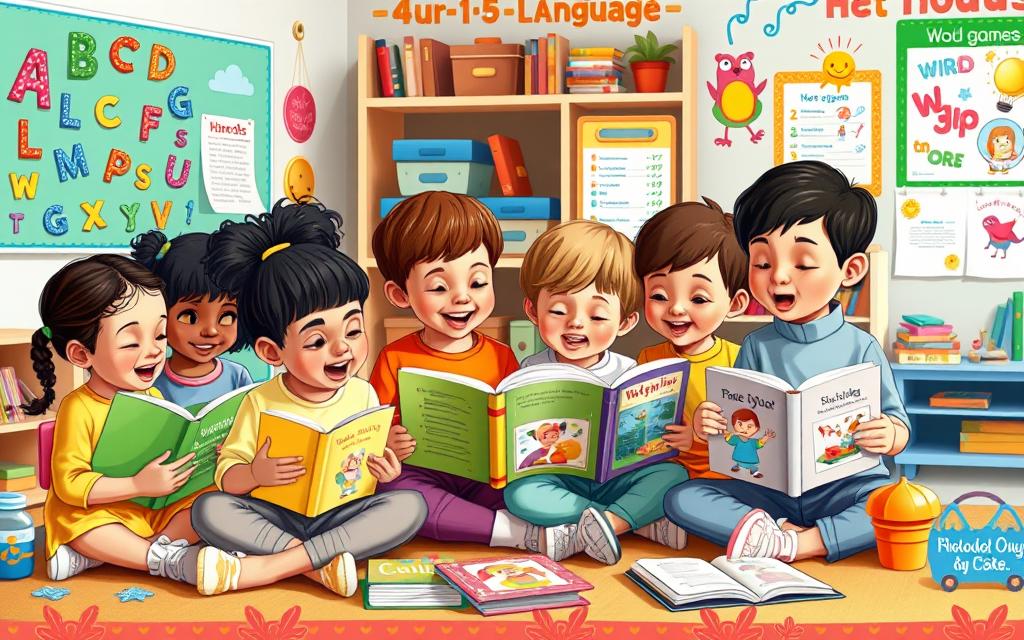
Parents need to know these warning signs and act fast if they see them. Early action can help a child overcome language issues and reach their full linguistic milestone potential.
The Impact of Technology on Language Learning
Technology is a big part of our lives today. It plays a key role in how we learn languages. As kids grow, they hit different language learning marks. Technology can help or hurt their progress.
The American Academy of Pediatrics says parents need to watch how tech affects language learning. They should follow screen time rules to help kids develop language healthily.
Learning languages is very important for young kids. Too much screen time can hurt their language skills, especially if they start early. But watching screens with an adult can help kids learn more.
Parents need to balance digital time with real-life talks. This helps kids develop their language skills better.

- Following screen time guidelines to ensure healthy language development
- Engaging in co-viewing and interactive activities with their child
- Encouraging language skills development through play and conversation
By understanding how tech affects language learning, parents can help their kids reach important language goals. This supports their language skills growth.
Multilingual Development in Children
Studies show that growing up with multiple languages can boost a child’s mind and social skills. Yet, it can also pose challenges for learning languages. Kids raised in homes where more than one language is spoken follow similar language development milestones as those who speak only one language. However, they might face some unique hurdles in their language acquisition stages.
Bilingual kids start babbling and using simple sounds around the same time as kids who speak one language. But, they might need a bit more time to form their first sentences. By the time they are 24 months old, bilingual children are mostly understood by others. They also have a vocabulary of about 200-300 words across all languages they know.
Some important language development milestones for bilingual kids include:
- Using three-word phrases by the age of three
- Having a vocabulary of around 1,000 words across all languages by the age of three
- Being able to engage in conversations and use full sentences by the age of four
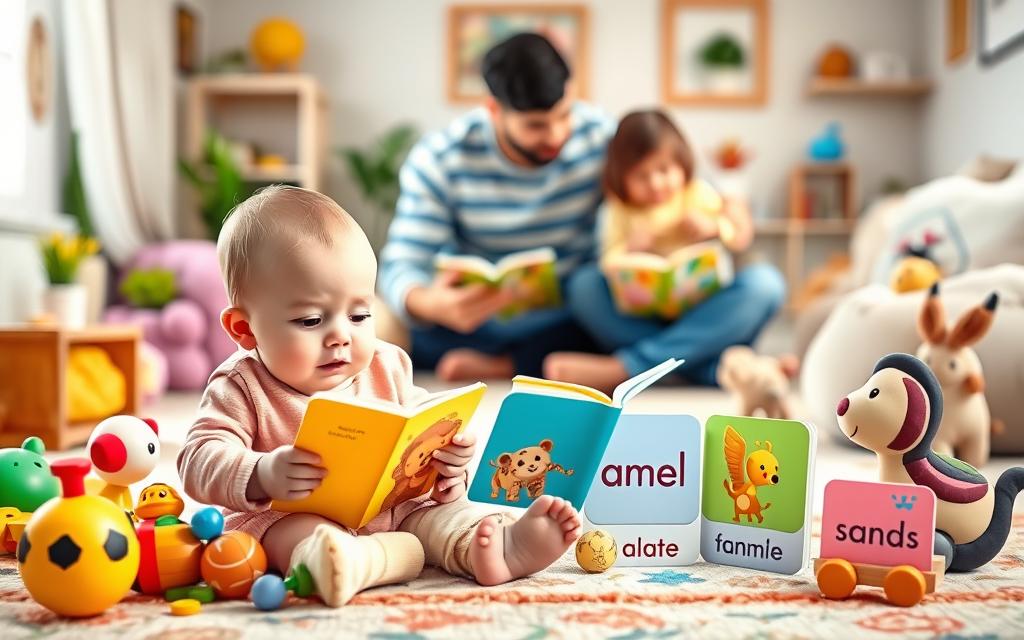
Overall, growing up with multiple languages can be a rewarding and enriching experience. With the right support, children can excel in multilingual environments. They can reach their full potential in language acquisition stages.
Nurturing Your Child’s Language Journey
As your child explores the world of language, it’s key to create a supportive space for them. Language development milestones help parents see how their child is doing. By knowing language acquisition stages and helping with speech development milestones, you help your child grow in language.
Every child’s path in learning language is different. With patience and the right help, your child will keep growing. Enjoy watching your child learn and grow as they discover how to communicate.
Key Takeaways
- Language development milestones are crucial for a child’s cognitive and social growth.
- By 3 months, 85% of infants respond to their name and familiar voices.
- Early intervention can improve language outcomes by up to 50%.
- Language acquisition stages involve speaking, listening, reading, and writing skills.
- Speech development milestones are significant indicators of a child’s language development progress.
- Understanding language development milestones helps identify potential language disorders.
- Supporting language development requires a comprehensive approach, including language-rich environments and daily reading activities.
Source Links
- Age-Appropriate Speech and Language Milestones – https://www.chop.edu/health-resources/age-appropriate-speech-and-language-milestones
- Language development in children: 0-8 years – https://raisingchildren.net.au/babies/development/language-development/language-development-0-8
- Speech and Language Developmental Milestones – https://www.nidcd.nih.gov/health/speech-and-language
- Understanding language development milestones – https://medicine.yale.edu/news-article/understanding-language-development-milestones/
- Age-Appropriate Speech and Language Milestones – https://www.stanfordchildrens.org/en/topic/default?id=age-appropriate-speech-and-language-milestones-90-P02170
- The Journey of Communication Development – Kutest Kids – https://www.kutestkids.com/blog/communication-development-milestones
- Communication: Infants and Toddlers | Virtual Lab School – https://www.virtuallabschool.org/infant-toddler/communication-and-language-development/lesson-2
- Speech and language development from birth to 12 months – https://www.gosh.nhs.uk/conditions-and-treatments/procedures-and-treatments/speech-and-language-development-birth-12-months/
- Speech and language skills: newborn to 2 years – https://www.chrichmond.org/services/therapy-services/developmental-milestones/speechlanguage-skills-birth-to-2-years
- Language Development Stages & Developing Language At-Home – https://www.healthyyoungminds.com/language-development-stages-developing-language-at-home/
- Speech milestones for babies to look out for – https://www.mayoclinic.org/healthy-lifestyle/infant-and-toddler-health/in-depth/language-development/art-20045163
- Baby Language Milestones 0 to 12 months: Cooing, Laughing, and Mo – https://www.healthline.com/health/baby/language-milestones-0-to-12-months
- Speech Milestones for Babies 6-12 months – https://www.baby-chick.com/speech-milestones-for-babies-6-12-months/
- Speech and language development (from 12 to 24 months) – https://www.gosh.nhs.uk/conditions-and-treatments/procedures-and-treatments/speech-and-language-development-12-24-months/
- Language development: 1-2 years – https://raisingchildren.net.au/toddlers/development/language-development/language-1-2-years
- Language development: 3-4 years – https://raisingchildren.net.au/preschoolers/development/language-development/language-3-4-years
- Language and Speech Skills for Children Ages 3-4 Years – https://together.stjude.org/en-us/emotional-support-daily-life/early-childhood-development/language-development-3-to-4-years.html
- Communication: Preschool Children | Virtual Lab School – https://www.virtuallabschool.org/preschool/communication-and-language-development/lesson-2
- Language development: 4-5 years – https://raisingchildren.net.au/preschoolers/development/language-development/language-4-5-years
- Developmental Milestones: 4 to 5 Year Olds (Preschool) – Children’s Hospital of Orange County – https://choc.org/primary-care/ages-stages/4-to-5-years/
- 4 Year Old Speech Checklist: Speech and Language Milestones – https://www.speechandlanguagekids.com/what-speech-and-language-skills-should-my-4-year-old-have/
- How To Help Your Child’s Language Development? – https://www.carepointeacademy.com/blog/posts/8-tips-to-support-your-childs-language-development
- Stages of Language Development Chart – Kid Sense Child Development – https://childdevelopment.com.au/resources/child-development-charts/stages-of-language-development-chart/
- Helping Toddlers Expand Language Skills – Child Mind Institute – https://childmind.org/article/helping-toddlers-expand-their-language-skills/
- Red Flags for Language Development: Birth-36 Months – https://www.nspt4kids.com/parenting/language-development-red-flags-ages-0-36-months
- Speech and Language Development: Milestones and Red Flags – Oaklawn Hospital – https://oaklawnhospital.org/blog/speech-and-language-development-milestones-and-red-flags/
- Speech and language delay in children: a practical framework for primary care physicians – https://pmc.ncbi.nlm.nih.gov/articles/PMC10775292/
- The influence of screen time on children’s language development: A scoping review – https://pmc.ncbi.nlm.nih.gov/articles/PMC8905397/
- The Relationship between Language and Technology: How Screen Time Affects Language Development in Early Life—A Systematic Review – https://pmc.ncbi.nlm.nih.gov/articles/PMC10813394/
- A Developmental Perspective on Technology in Language Education – https://education.uci.edu/uploads/7/2/7/6/72769947/developmental1.pdf
- Speech and Language Development in Bilingual Children – https://www.sunnydays.com/blog/speech-language-development-bilingual-children
- Bilingualism in the Early Years: What the Science Says – https://pmc.ncbi.nlm.nih.gov/articles/PMC6168212/
- PDF – https://arts.unimelb.edu.au/__data/assets/pdf_file/0010/3546379/Language_development.pdf
- Enhance Child Language Development: Guide for Parents – https://www.mywellnesshub.in/blog/boost-child-language-development/
- Language and Cognitive Development: Key Milestones for Parents – https://www.beibeiamigos.com/language-and-cognitive-development-what-every-parent-should-know/

